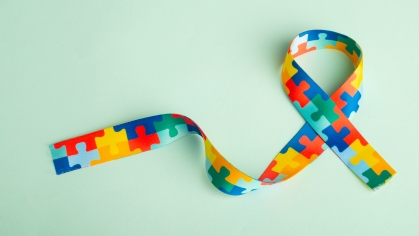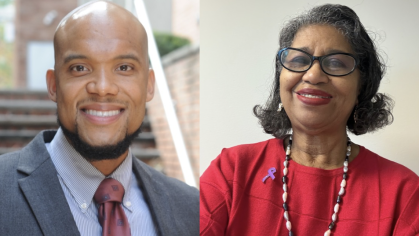By Mary Beth Ali, Teaching Instructor and Coordinator of Field Education
What does December 1, 2021 mean to you? Some say it marks the beginning of the holiday season, the lighting of the Rockefeller Christmas Tree, the third day of Hanukkah, or the opening of the first door of the advent calendar. But those who lived during the last two decades of the 20th century may know it as World AIDS (Acquired Immune Deficiency Syndrome) Day, a day dedicated to recognizing HIV (Human Immunodeficiency Virus) and its effects globally.
World AIDS Day recognition has taken place on December 1 every year since 1988. It is the first-ever international heath day recognized, uniting people worldwide in the fight against HIV and commemorating those living with and those who have died from an AIDS-related illness. At that time, conservative heteronormative global leaders believed HIV was a disease confined to men having sex with men (MSM) and intravenous drug users (IVDU), leaving the heteronormative public to believe they were not at risk for the virus. Although this logic was deeply flawed, it mobilized the MSM and medical communities across the globe to increase funding for research, supplying life-saving resources to otherwise marginalized and underserved populations.
My journey to social work is rooted in serving those infected and affected with HIV. As a young social activist, I learned about the vast scope of the social work profession, advocating for equity, and raising awareness. Hearing devastating narratives from HIV+ individuals who experienced social isolation because of their positive diagnosis, made me want to work even closer with them. In response to their deaths, I promised to commit to serving these individuals living with HIV. Upon making this commitment, I realized I needed to pursue a degree in social work. I was the only student in my BSW program working with individuals infected and affected with HIV. My first and most rewarding social work position is as a medical infectious disease social worker. I have continued to serve in this capacity for more than twenty-five years, not only evolving my scope of practice across micro and macro-HIV platforms but, most notably, working side by side with thousands of individuals infected and affected with HIV.
Much has changed in how society views HIV since I began my career three decades ago. Nowadays, you might ask a member of Generation X, Y, or Z what they know about HIV, and some may reply, “HIV? That is not around anymore. Yes, there are commercials on TV about pills to treat HIV, but it is not something that concerns me.” In 2006, the Centers for Disease Control (CDC) recommended medical professionals screen all persons aged 13-64 for HIV at least once (Branson et al., 2006). Yet, as of 2020, UNAIDS (2021) reports that over thirty-seven million people globally live with HIV, adding 1.5 million newly diagnosed individuals to the prior year’s total. However, Hoover et al. (2020) report ambulatory care settings continue to overlook screening for HIV, citing over eight years, HIV testing occurred less than one percent in physician’s offices and less than three percent at community health centers. So, ask yourself, have your medical providers discussed or ordered an HIV test for you?
Today we continue to grapple with COVID-19, but we can use the lessons we learned during the pandemic and apply them to HIV. Americans quickly realized that whether they were symptomatic or asymptomatic, they must get a test to know their COVID-19 status. A few months after the 2020 outbreak, COVID-19 drive through centers opened and were met with swarms of individuals eagerly waiting several hours, and even overnight in some cases, to receive a COVID-19 test. As the media reported increased positive transmission rates hour by hour, individuals recognized their potential risk for exposure and turned to science for answers. Preventative measures, such as wearing personal protective equipment, donning facial masks, washing, sanitizing hands often, and supporting social distancing, became typical.
Just like people were interested in knowing their COVID-19 status, people should know their HIV status. Unless one seeks out a test for HIV, one will not know if they are living with the virus and unknowingly continue to pass the virus onto other individuals. Despite the progress made with the 2006 CDC recommendation, it falls short of not being a requirement. Yet to follow this recommendation, the medical community needs to start and incorporate HIV testing into primary care for all individuals living in the USA. Without testing, the transmission rate continues to be underreported, suggesting that HIV is not a medical concern for anyone aged 13 to 64 in the USA. In addition, people need to know that HIV can infect anyone regardless of their demographic and intersectional representation.
This World AIDS Day, 2021, I hope you:
- Reflect on your positionality to acknowledge and address unconscious HIV stigmas and bias.
- Challenge the socially constructed misconceptions of living with HIV through exploring evidence-based research. https://www.hiv.gov/
- Get tested: visit your county testing site to know your HIV status.
- Be an ally for those infected with and affected by HIV.
Branson, B., Hansfield, H., Lampe, M., Jannsen, R., Taylor, A., Lyss, S., Clark, J. (2006). Revised Recommendations for HIV Testing of Adults, Adolescents, and Pregnant Women in Health-Care Settings. Center for Disease Control and Prevention, Morbidity and Mortality Weekly Report (MMWR)55(RR14);1-17. https://www.cdc.gov/mmwr/preview/mmwrhtml/rr5514a1.htm
Hoover, K., Huang, Y., Tanner, M., Zhu, W., Gathua, N., Pitasi, M., DiNenno, E., Nair, S., Delaney, K. (2020). HIV Testing Trends at Visits to Physician Offices, Community Health Centers, and Emergency Departments — United States, 2009–2017. Center for Disease Control and Prevention, Morbidity and Mortality Weekly Report (MMWR)69 (25) 776-780.https://www.cdc.gov/mmwr/volumes/69/wr/mm6925a2.htm
UNAIDS (2021). Global HIV & AIDS statistics — Fact sheet. https://www.unaids.org/en/resources/fact-sheet
This story was created in partnership with Rutgers School of Social Work's Inclusion, Intersectionality, Diversity, Equity, and Advancement (IIDEA) Committee in support of our commitment to diversity, equity, and inclusion.



